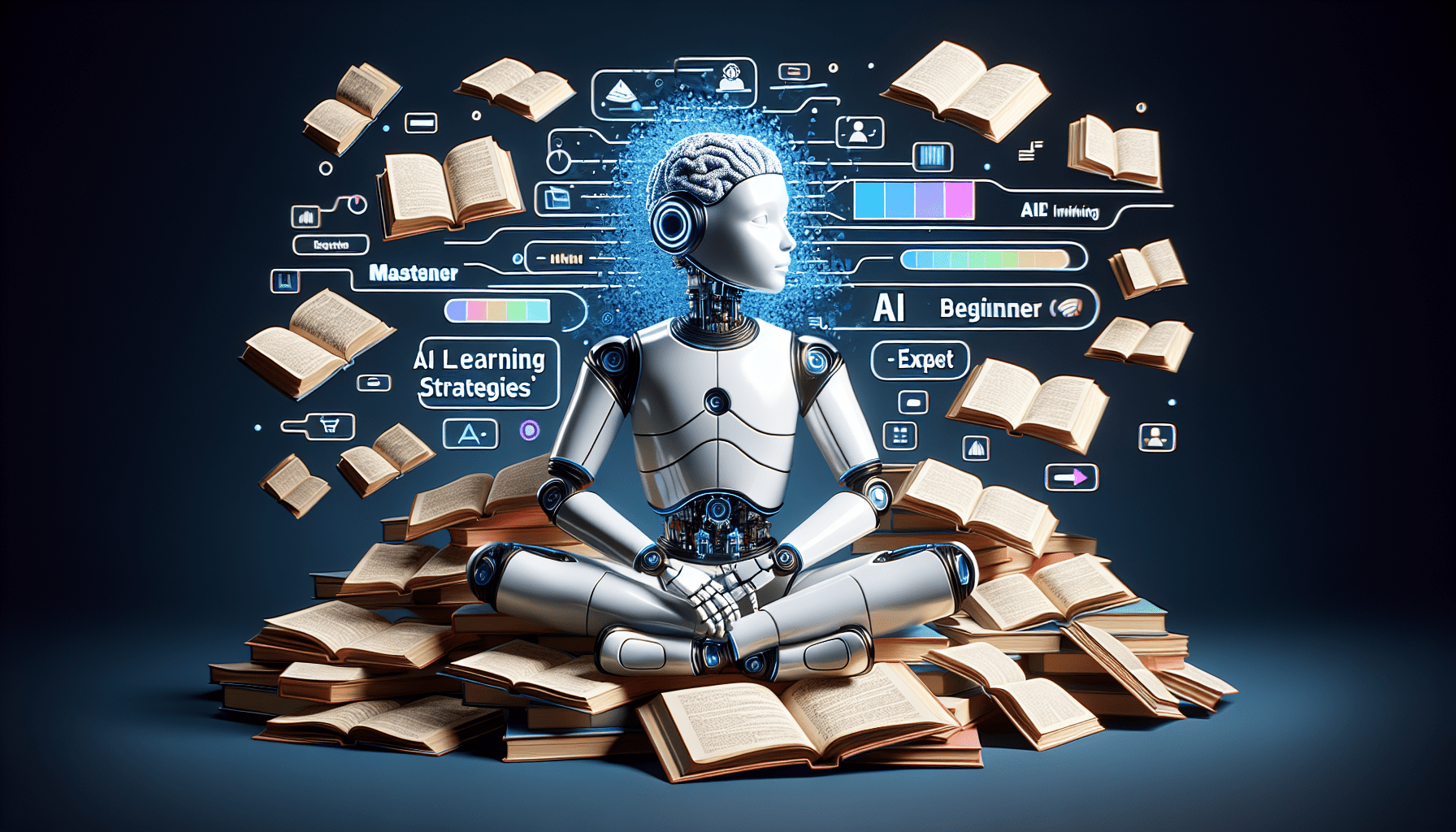Are you eager to delve into the world of Artificial Intelligence (AI), but unsure where to start? Look no further! In this article, we will guide you towards mastering AI effortlessly with simple learning strategies. Whether you have a strong technical background or are a complete novice, these strategies will help you acquire the knowledge and skills needed to excel in the field of AI. Get ready to embark on a journey towards becoming a master of AI in no time!
Understanding AI
What is AI?
AI, or Artificial Intelligence, refers to the development of intelligent machines that can perform tasks that would typically require human intelligence. These tasks include speech recognition, decision-making, problem-solving, learning, and more. AI systems are designed to analyze and interpret vast amounts of data, enabling them to make predictions, recognize patterns, and adapt to changing circumstances.
Types of AI
There are three main types of AI: narrow AI, general AI, and superintelligent AI. Narrow AI focuses on specific tasks and is limited to a narrow domain, such as voice assistants or image recognition systems. General AI, on the other hand, has a broader understanding and can handle various tasks similar to human intelligence. Lastly, superintelligent AI refers to AI systems that surpass human intelligence and have the ability to outperform humans in virtually every aspect.
Importance of AI in today’s world
AI plays a crucial role in today’s world, as it has the potential to transform various industries and improve our overall quality of life. It has already made significant advancements in healthcare, finance, transportation, and more. AI-driven technologies have the ability to analyze medical data to assist in disease diagnosis, optimize financial investments, develop autonomous vehicles, and even personalize our online experiences. Understanding AI is becoming increasingly essential as it continues to shape and reshape our world.
Building a strong foundation
Basics of programming
Mastering the basics of programming is a crucial step in learning AI. Programming languages like Python, Java, and R are commonly used in AI development. Python, in particular, is highly recommended for beginners due to its simplicity and extensive library support. Learning the fundamentals of programming concepts, such as variables, loops, conditionals, functions, and object-oriented programming, will provide a solid foundation for implementing AI algorithms and models.
Mathematics for AI
A solid understanding of mathematics is vital for AI, as it forms the backbone of many AI algorithms and techniques. Concepts like linear algebra, calculus, probability, and statistics are extensively used in AI. Linear algebra is particularly important for understanding matrix operations and vector spaces, which are fundamental to neural networks. Calculus helps in optimizing AI models, while probability and statistics are used for data analysis and making predictions. Strengthening your mathematical skills will help you grasp AI concepts more effectively.
Data structures and algorithms
Data structures and algorithms are essential for efficiently managing and processing data in AI applications. By understanding various data structures like lists, arrays, queues, stacks, trees, and graphs, you can effectively organize and manipulate data. Algorithms, such as sorting, searching, and graph algorithms, enable you to analyze data patterns, make predictions, and optimize AI models. Learning data structures and algorithms will improve your ability to solve complex AI problems and enhance the performance of your models.

Learning AI languages
Python
Python is widely regarded as one of the best programming languages for AI and data science. Its simplicity, readability, and extensive library ecosystem (including popular libraries like NumPy, Pandas, and Scikit-learn) make it an ideal choice for beginners. Python allows you to write concise and expressive code, making AI development more intuitive and efficient. By learning Python, you will have a versatile and powerful tool for implementing various AI algorithms and models.
R
R is another popular programming language commonly used in statistical analysis and data visualization, making it a valuable language for AI. It provides a wide range of packages specifically designed for data analysis and machine learning. R is especially useful when dealing with large datasets and conducting exploratory data analysis. Learning R alongside Python will give you a broader skillset and enable you to choose the best tool for different AI tasks.
Java
Java, with its robust and versatile nature, remains a strong contender in the world of AI. Although Java may not be as popular as Python or R in the AI community, it still offers advantages. Java’s scalability, platform independence, and extensive libraries (such as Deeplearning4j and DL4J) make it an excellent option for building large-scale AI applications that require high performance and stability. Familiarizing yourself with Java will provide you with broader options and opportunities in the field of AI.
Exploring AI frameworks
TensorFlow
Developed by Google, TensorFlow is one of the most popular and widely used AI frameworks. It provides a comprehensive ecosystem for building and deploying machine learning models. TensorFlow’s versatility and scalability make it suitable for various AI applications, from natural language processing to computer vision. With TensorFlow, you can efficiently implement neural networks and leverage pre-trained models. Its visualization tools and flexible architecture make it easier to understand and debug your AI models.
PyTorch
PyTorch is a powerful open-source machine learning library known for its dynamic computational graphs and ease of use. It has gained significant popularity in the AI community due to its intuitive syntax and flexibility. PyTorch allows you to experiment with and debug your models more efficiently, making it a preferred choice for research projects. Its strong community support and extensive documentation make it easier for beginners to grasp complex AI concepts.
Keras
Keras is a user-friendly neural network library written in Python. It provides a high-level abstraction on top of TensorFlow and other backends, simplifying the implementation of deep learning models. Keras offers an intuitive and flexible API, allowing you to build, train, and deploy neural networks with ease. It is particularly suitable for beginners as it abstracts away the complexities of low-level coding, enabling you to focus more on the architectural aspects of your models.

Mastering machine learning
Supervised learning
Supervised learning is a type of machine learning where the model learns from labeled data to make predictions or decisions. It involves training an AI model on input-output pairs, allowing it to recognize patterns and generalize to new, unseen data. Common algorithms used in supervised learning include linear regression, decision trees, support vector machines, and neural networks. By understanding and mastering supervised learning techniques, you can build accurate prediction models for various real-world problems.
Unsupervised learning
Unlike supervised learning, unsupervised learning deals with unlabeled data, where the model learns to find hidden patterns or structures within the dataset. Unsupervised learning algorithms are commonly used for clustering, anomaly detection, and dimensionality reduction. Popular unsupervised learning techniques include k-means clustering, hierarchical clustering, principal component analysis (PCA), and autoencoders. Mastering unsupervised learning enables you to uncover valuable insights and gain a deeper understanding of complex datasets.
Reinforcement learning
Reinforcement learning involves training an AI agent to interact with an environment and learn optimal actions through trial and error. The agent receives feedback in the form of rewards or penalties, guiding its decision-making process. Reinforcement learning algorithms aim to maximize the cumulative reward over time, allowing the agent to improve its performance through continuous learning. Understanding the fundamentals of reinforcement learning enables you to build AI systems capable of making optimal decisions in dynamic and uncertain environments.
Understanding neural networks
Introduction to neural networks
Neural networks are a fundamental concept in AI and are based on the structure and function of the human brain. They consist of interconnected layers of artificial neurons called nodes or units. These nodes process and transmit information, allowing the network to learn and make predictions. Neural networks can be shallow with only a few layers or deep with multiple layers, known as deep learning. Deep learning has revolutionized various domains, including image recognition, natural language processing, and recommendation systems.
Types of neural networks
There are several types of neural networks, each designed for specific tasks and data types. Some common types include:
-
Feedforward Neural Networks: The most basic type of neural network, where information flows in one direction, from input to output.
-
Convolutional Neural Networks (CNN): Optimized for image and video processing, using specialized layers to capture spatial hierarchies and patterns.
-
Recurrent Neural Networks (RNN): Ideal for sequential data, such as text and speech, due to their ability to retain context through recurrent connections.
-
Long Short-Term Memory Networks (LSTM): A variant of RNNs, designed to combat the vanishing gradient problem and effectively capture long-term dependencies in sequential data.
Understanding the different types of neural networks allows you to choose the most appropriate architecture for your specific AI task.
Training neural networks
Training neural networks involves the process of iteratively optimizing the network’s weights and biases to minimize the prediction error. This process is known as backpropagation. It involves forward propagating input data through the network, calculating the prediction error, and then adjusting the weights and biases in the opposite direction of the error gradient. This iterative process continues until the network learns to make accurate predictions on the training data. Learning how to train neural networks effectively is a crucial skill in AI, as it directly impacts the model’s performance and generalization ability.

Working with data
Data preprocessing
Data preprocessing involves transforming raw data into a format suitable for AI algorithms and models. This often includes steps like data cleaning, handling missing values, feature scaling, and encoding categorical variables. Data preprocessing ensures that the data is consistent, complete, and relevant, leading to more accurate and reliable AI models. Understanding different data preprocessing techniques and their impact on the model’s performance is essential for obtaining good results.
Feature selection and extraction
Feature selection and extraction aim to identify and select the most relevant and informative features from a dataset. This process helps reduce dimensionality, improves model performance, and speeds up training time. Feature selection techniques include statistical methods, such as correlation analysis and feature importance rankings. Feature extraction methods involve transforming features into a lower-dimensional space using techniques like Principal Component Analysis (PCA) or t-SNE. Mastering feature selection and extraction enables you to create compact and effective AI models.
Data cleaning and visualization
Data cleaning involves identifying and correcting or removing errors, inconsistencies, or inaccuracies in the dataset. This ensures that the data is reliable and ready for analysis. Data visualization, on the other hand, helps gain insights and understand the underlying patterns or trends within the data. By effectively visualizing the data, you can communicate your findings and make informed decisions. Learning data cleaning techniques and visualization tools allows you to work with real-world datasets and extract meaningful insights for AI applications.
Enhancing AI performance
Optimization techniques
Optimization techniques aim to improve the performance of AI models by fine-tuning their parameters. Techniques like gradient descent, stochastic gradient descent, and Adam optimization help update the model’s parameters and minimize the loss function during training. These algorithms play a crucial role in achieving faster convergence and better model generalization. Understanding optimization techniques allows you to optimize AI models for improved performance and efficiency.
Hyperparameter tuning
Hyperparameters are parameters that are set before the learning process begins, such as learning rate, batch size, and number of hidden layers. Fine-tuning these hyperparameters can significantly impact the model’s performance. Hyperparameter tuning techniques, such as grid search, random search, and Bayesian optimization, help systematically explore different combinations of hyperparameters to find the optimal configuration. Mastering hyperparameter tuning enables you to fine-tune your AI models and achieve better results.
Regularization methods
Regularization methods help prevent overfitting, where the model performs well on the training data but fails to generalize on unseen data. Techniques like L1 and L2 regularization, dropout, and early stopping aid in controlling model complexity and reducing the impact of noise in the training data. Understanding regularization methods enables you to build more robust and resilient AI models that can handle diverse and noisy real-world datasets.

Implementing AI models
Creating a basic AI model
Creating a basic AI model involves implementing the learned concepts and techniques to solve a specific problem. Starting with a simple dataset and a chosen algorithm, you build a pipeline that includes data preprocessing, model training, and evaluation. By gradually enhancing the model with more advanced techniques, you can improve its performance and make it more robust. Creating a basic AI model helps you gain hands-on experience and solidify your understanding of AI concepts.
Fine-tuning existing models
Instead of building an AI model from scratch, another approach is to fine-tune pre-existing models. Pre-trained models, such as those available in popular AI libraries, are trained on large datasets and can be further customized to suit specific tasks. By leveraging transfer learning, you can use a pre-trained model as a starting point and retrain it on your own dataset. Fine-tuning existing models saves time and computational resources while still achieving competitive performance.
Deploying AI models
Once you have developed and fine-tuned an AI model, deploying it into a production environment is the final step. This involves integrating the model into applications or systems that can utilize its predictions in real-time. Deployment considerations include choosing the appropriate hardware, optimizing the model for performance, and ensuring its reliability, scalability, and security. Understanding the deployment process allows you to deliver AI models that can make a practical impact and facilitate automation in various domains.
Staying updated and practicing
Keeping up with AI advancements
AI is a rapidly evolving field, with new advancements and research being published regularly. Staying updated with the latest developments, breakthroughs, and trends is crucial for success in AI. This involves reading research papers, following AI-focused blogs and publications, and actively participating in online communities and forums. By staying connected and updated, you can incorporate the latest techniques and stay ahead in the rapidly changing AI landscape.
Participating in Kaggle competitions
Kaggle is a popular platform that hosts data science and machine learning competitions. Participating in these competitions allows you to apply your AI skills to real-world problems, work with diverse datasets, and compete with other AI enthusiasts. Kaggle provides an opportunity to refine your AI techniques, learn from other participants, and gain practical experience in tackling complex problems. Engaging in Kaggle competitions can help sharpen your AI skills and enhance your problem-solving abilities.
Building personal projects
Building personal AI projects is a valuable way to put your skills into practice and showcase your abilities to potential employers or collaborators. By working on projects that align with your interests, you can explore different AI techniques, experiment with various datasets, and develop a strong portfolio. Personal projects enable you to gain hands-on experience, demonstrate your understanding of AI concepts, and continuously improve your capabilities.
Mastering AI may seem like a daunting task, but with the right approach and a comprehensive understanding of the necessary foundations, languages, frameworks, and concepts, you can navigate the world of AI with ease. Remember to build a strong foundation in programming, mathematics, and data structures and algorithms. Learn popular AI languages like Python, R, and Java, and explore AI frameworks such as TensorFlow, PyTorch, and Keras. Master machine learning algorithms and understand neural networks, while also working with data and enhancing AI performance through optimization, hyperparameter tuning, and regularization. Implementing AI models, staying updated with advancements, and practicing through personal projects and Kaggle competitions will further solidify your knowledge and skills. So get started, embrace the challenges, and embark on your journey to become a proficient AI practitioner.







Leave a Reply